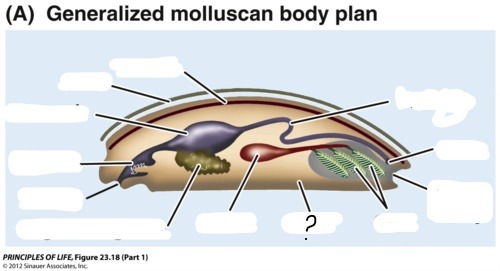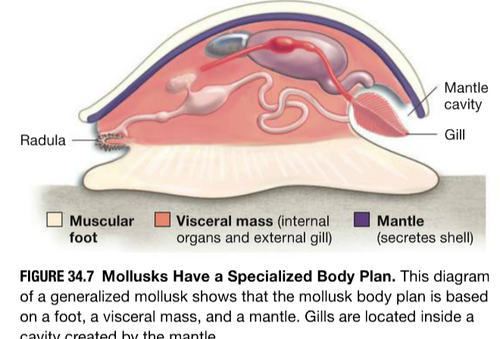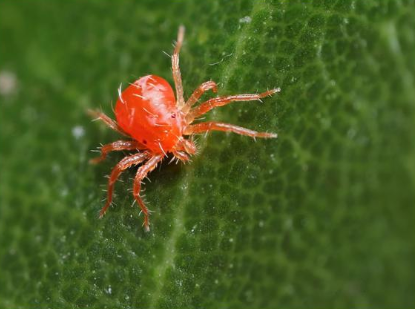Lecture 19 Key Concepts/Terms
0.0(0)
Card Sorting
1/45
Earn XP
Description and Tags
Study Analytics
Name | Mastery | Learn | Test | Matching | Spaced |
|---|
No study sessions yet.
46 Terms
1
New cards
what did the common ancestor of mollusks look like?
the ancestor to all is some sort of unsegmented worm
2
New cards
visceral mass (mollusks)
contains internal organs, excretion, and reproduction
3
New cards
foot (mollusks)
used for locomotion

4
New cards
mantle (mollusks)
secretes the shell and covers the gills

5
New cards
cephalization in mollusks
cephalopods and gastropods have a distinct head
bivalves=no head
chitons have mouth parts but no head
mollusks have variable levels of cephalization
bivalves=no head
chitons have mouth parts but no head
mollusks have variable levels of cephalization
6
New cards
radula
An organ covered with teeth that mollusks use to scrape food into their mouths
7
New cards
mollusk reproduction
cross fertilization common in all mollusks
gastropods - internal fertilization
bivalves and many gastropods - hermaphroditic
some sea slugs and oysters can change their sex
gastropods - internal fertilization
bivalves and many gastropods - hermaphroditic
some sea slugs and oysters can change their sex
8
New cards
Polyplacophora (chitons)
bodies with 8 dorsal plates
herbivorous
some have internal fertilization and internal digestion
typically live in shallow water
herbivorous
some have internal fertilization and internal digestion
typically live in shallow water
9
New cards
gastropods
snails and slugs
some free-swimming, others creep
tentacles are common
chemo or mechano-sensing eyes
the only terrestrial mollusks
some free-swimming, others creep
tentacles are common
chemo or mechano-sensing eyes
the only terrestrial mollusks
10
New cards
bivalves (oysters, clams)
ligaments hold shells closed
most filter feed
have incurrent and excurrent syphons
sedentary adults
free-swimming larvae
most filter feed
have incurrent and excurrent syphons
sedentary adults
free-swimming larvae
11
New cards
incurrent and excurrent syphons
Extract small organisms form water and bring into body through incurrent syphon
Exit through excurrent syphon
Exit through excurrent syphon
12
New cards
cephalopods (octopus, squid, nautili)
marine predators
arms and tentacles
color changing
jet propulsion
highly intelligent
arms and tentacles
color changing
jet propulsion
highly intelligent
13
New cards
what makes an ecdysozoan?
they grow by molting
monophyletic
monophyletic
14
New cards
nematodes (roundworms)
pseudocoelomates
typically parasitic
separate sexes (not hermaphroditic)
hydrostatic skeleton
typically parasitic
separate sexes (not hermaphroditic)
hydrostatic skeleton
15
New cards
eutely
condition of a body composed of a constant number of cells or nuclei in all adult members of a species, as in rotifers, acanthocephalans, and nematodes
16
New cards
model organisms
organisms studied by many different researchers so they can compare their results and determine scientific principles that apply more broadly to other species
ex.) fruit flies
ex.) fruit flies
17
New cards
horsehair worms
parasites of arthropods
only 350 species
variable length
either free-living or parasitic
adults may not eat
only 350 species
variable length
either free-living or parasitic
adults may not eat
18
New cards
paired appendages
arthropods and their relatives are a monophyletic group united by having what?

19
New cards
Water bears (tardigrades)
fleshy appendages
extremely small
can be dormant for long periods
extremely small
can be dormant for long periods
20
New cards
ecdysozoan
protostome characterized by periodic molting of their exoskeleton, includes the roundworms and arthropods.
21
New cards
lophotrochozoans
Brachiopods
Mollusks (chitons, bivalves, gastropods and cephalopods)
Annelids
Mollusks (chitons, bivalves, gastropods and cephalopods)
Annelids
22
New cards
velvet worms
closely related to arthropods
terrestrial
segmented bodies
fleshy, unjointed bodies
external cuticle containing chitin
internal fertilization and egg development
terrestrial
segmented bodies
fleshy, unjointed bodies
external cuticle containing chitin
internal fertilization and egg development
23
New cards
what did the common ancestor of the arthropods probably look like?
a velvet worm
24
New cards
species richness in arthropods
arthropods are 2/3 of all species
25
New cards
trilobites
early arthropod that lives during the Paleozoic era
had jointed appendages
had jointed appendages
26
New cards
four groups of arthropods
arachnids
crustaceans
myriapods
insects
crustaceans
myriapods
insects
27
New cards
jointed appendages
head, thorax and abdomen in arthropods
28
New cards
exoskeletons in arthropods
from excreted chitin and protein, what muscles are
attached to, new one is grown under one that shed
attached to, new one is grown under one that shed
29
New cards
molting in arthropods
new skeleton grows under the old one and the old one sheds
30
New cards
limitations places on organisms with exoskeletons
the organism stays small because of the exoskeleton
the exoskeleton must get thicker to be able to hold weight
the exoskeleton must get thicker to be able to hold weight
31
New cards
arachnids
mouthparts - chelicerae
no antennae or wings
8 legs
spiders, scorpions, mites
no antennae or wings
8 legs
spiders, scorpions, mites
32
New cards
myriapods
mouthparts - mandibles
bodies consists of head and repeated segments
some have variable tail segments
single antennae pair, no wings
centipedes and millipedes
bodies consists of head and repeated segments
some have variable tail segments
single antennae pair, no wings
centipedes and millipedes
33
New cards
crustaceans
mouthparts - mandibles
two pairs of antennae
5 pairs of legs, some front pairs modified into claws
shrimp, lobsters, crabs, pill bugs
two pairs of antennae
5 pairs of legs, some front pairs modified into claws
shrimp, lobsters, crabs, pill bugs
34
New cards
insects (hexapods)
mouthparts - mandibles
bodies have three regions
one pair of antennae
6 legs
most have two pairs of wings
bodies have three regions
one pair of antennae
6 legs
most have two pairs of wings
35
New cards
slugs
gastropods which look like snails without shells
36
New cards
snails
Gastropods
37
New cards
Nudibranchs
marine gastropods that lack a shell (sea slugs)
38
New cards
clams
Bivalve mollusks / most their life buried in sand or seafloor or riverbeds
39
New cards
mussles
a mollusc with a black shell that can be eaten.
40
New cards
oyster
marine mollusks having a rough irregular shell
41
New cards
scallops
Types of mollusks called bivalves. These have many eyes and can swim.
42
New cards
octopus
a cephalopod mollusk with eight sucker-bearing arms, a soft saclike body, strong beaklike jaws, and no internal shell
43
New cards
squid
Cephalopod with a pen that serves as support; can change from red to gray; some deep living ones are huge
44
New cards
Nautilius
cephalopod
45
New cards
E) B and C
This is a picture of a/an:
A) an insect
B) an arthropod
C) an arachnid
D) A and B
E) B and C
A) an insect
B) an arthropod
C) an arachnid
D) A and B
E) B and C

46
New cards
Which of the following statements about mollusks is TRUE?
A) All mollusks have radulae
B) Some mollusks, but not all, have a variation of the 3-body part plan
C) Some mollusks, but not all, show signs of cephalization
D) Digestive organs typically form a cluster called the mantle
E) Cephalopods have lost their muscular foot
A) All mollusks have radulae
B) Some mollusks, but not all, have a variation of the 3-body part plan
C) Some mollusks, but not all, show signs of cephalization
D) Digestive organs typically form a cluster called the mantle
E) Cephalopods have lost their muscular foot
C) Some mollusks, but not all, show signs of cephalization